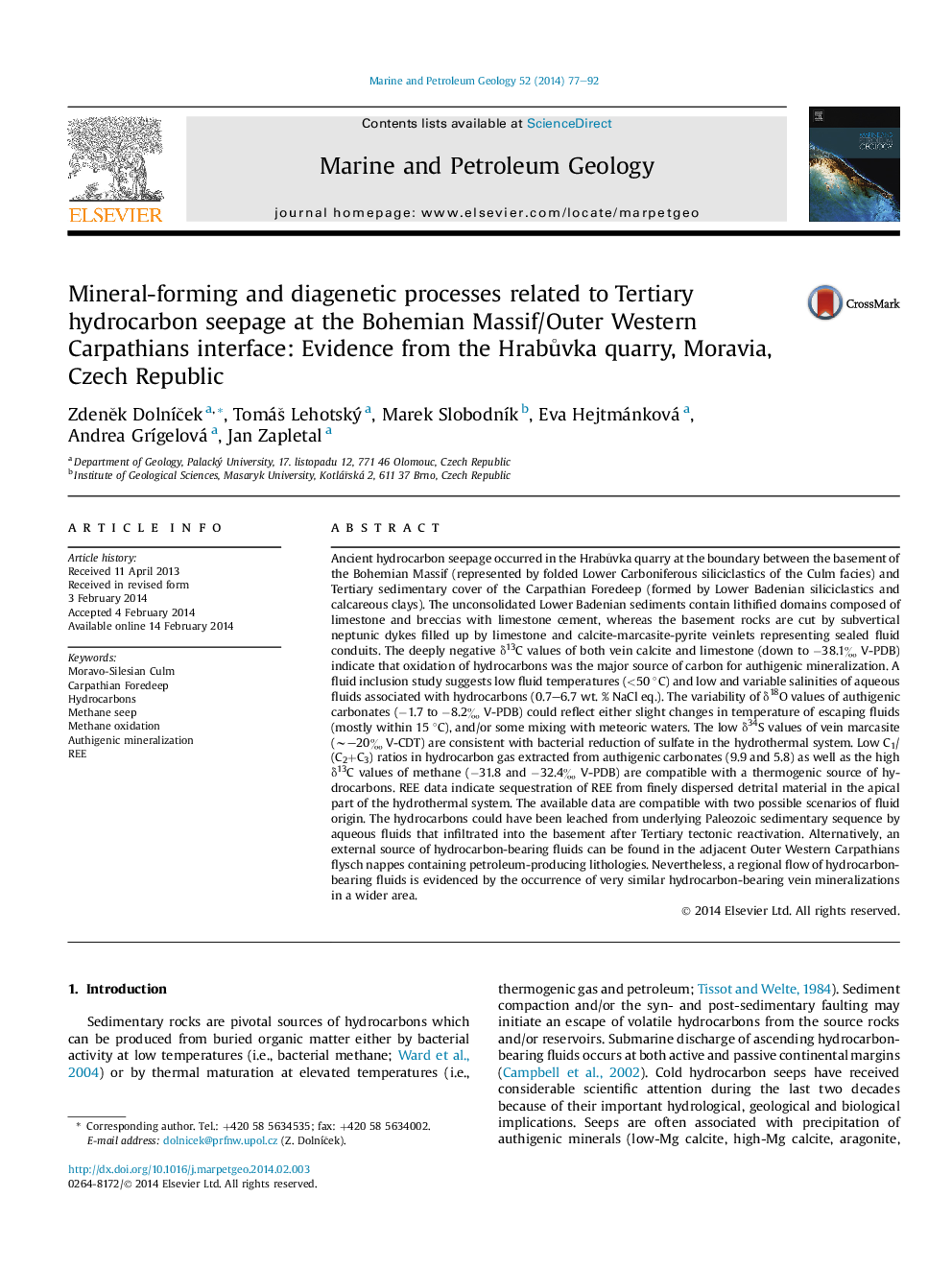| کد مقاله | کد نشریه | سال انتشار | مقاله انگلیسی | نسخه تمام متن |
|---|---|---|---|---|
| 6435470 | 1637172 | 2014 | 16 صفحه PDF | دانلود رایگان |

- Cold hydrocarbon seepage in contact zone between Paleozoic flysch siliciclastics and Tertiary cover.
- Diagenetic lithification of unconsolidated Tertiary sediments and formation of calcite-marcasite-pyrite veins.
- Hydrocarbon oxidation, bacterial sulfate reduction, REE scavenging from finely dispersed detrital material.
- Hydrocarbon source in either underlying Paleozoic bedrock or neighboring Carpathian flysch nappes.
Ancient hydrocarbon seepage occurred in the Hrabůvka quarry at the boundary between the basement of the Bohemian Massif (represented by folded Lower Carboniferous siliciclastics of the Culm facies) and Tertiary sedimentary cover of the Carpathian Foredeep (formed by Lower Badenian siliciclastics and calcareous clays). The unconsolidated Lower Badenian sediments contain lithified domains composed of limestone and breccias with limestone cement, whereas the basement rocks are cut by subvertical neptunic dykes filled up by limestone and calcite-marcasite-pyrite veinlets representing sealed fluid conduits. The deeply negative δ13C values of both vein calcite and limestone (down to â38.1â° V-PDB) indicate that oxidation of hydrocarbons was the major source of carbon for authigenic mineralization. A fluid inclusion study suggests low fluid temperatures (<50 °C) and low and variable salinities of aqueous fluids associated with hydrocarbons (0.7-6.7 wt. % NaCl eq.). The variability of δ18O values of authigenic carbonates (â1.7 to â8.2â° V-PDB) could reflect either slight changes in temperature of escaping fluids (mostly within 15 °C), and/or some mixing with meteoric waters. The low δ34S values of vein marcasite (â¼-20â° V-CDT) are consistent with bacterial reduction of sulfate in the hydrothermal system. Low C1/(C2+C3) ratios in hydrocarbon gas extracted from authigenic carbonates (9.9 and 5.8) as well as the high δ13C values of methane (â31.8 and â32.4â° V-PDB) are compatible with a thermogenic source of hydrocarbons. REE data indicate sequestration of REE from finely dispersed detrital material in the apical part of the hydrothermal system. The available data are compatible with two possible scenarios of fluid origin. The hydrocarbons could have been leached from underlying Paleozoic sedimentary sequence by aqueous fluids that infiltrated into the basement after Tertiary tectonic reactivation. Alternatively, an external source of hydrocarbon-bearing fluids can be found in the adjacent Outer Western Carpathians flysch nappes containing petroleum-producing lithologies. Nevertheless, a regional flow of hydrocarbon-bearing fluids is evidenced by the occurrence of very similar hydrocarbon-bearing vein mineralizations in a wider area.
Journal: Marine and Petroleum Geology - Volume 52, April 2014, Pages 77-92